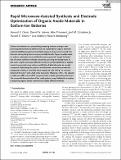Files in this item
Rapid microwave-assisted synthesis and electrode optimization of organic anode materials in sodium-ion batteries
Item metadata
| dc.contributor.author | Desai, Aamod V. | |
| dc.contributor.author | Rainer, Daniel Nikolaus | |
| dc.contributor.author | Pramanik, Atin | |
| dc.contributor.author | Cabañero, Joel M. | |
| dc.contributor.author | Morris, Russell E. | |
| dc.contributor.author | Armstrong, A. Robert | |
| dc.date.accessioned | 2021-11-11T12:30:01Z | |
| dc.date.available | 2021-11-11T12:30:01Z | |
| dc.date.issued | 2021-12-15 | |
| dc.identifier | 276445488 | |
| dc.identifier | 04c9296e-c411-4881-99a5-e1394b248236 | |
| dc.identifier | 85118863131 | |
| dc.identifier | 000716781000001 | |
| dc.identifier.citation | Desai , A V , Rainer , D N , Pramanik , A , Cabañero , J M , Morris , R E & Armstrong , A R 2021 , ' Rapid microwave-assisted synthesis and electrode optimization of organic anode materials in sodium-ion batteries ' , Small Methods , vol. 5 , no. 12 , 2101016 . https://doi.org/10.1002/smtd.202101016 | en |
| dc.identifier.issn | 2366-9608 | |
| dc.identifier.other | ORCID: /0000-0003-1937-0936/work/103137336 | |
| dc.identifier.other | ORCID: /0000-0001-7809-0315/work/103137489 | |
| dc.identifier.other | ORCID: /0000-0001-7219-3428/work/103138135 | |
| dc.identifier.uri | https://hdl.handle.net/10023/24313 | |
| dc.description | This work was supported by the Faraday Institution (Grant number—FIRG018). The authors also acknowledge the Engineering and Physical Sciences Research Council (EPSRC) Light Element Facility Grant (EP/T019298/1) and the EPSRC Strategic Equipment Resource Grant (EP/R023751/1). D.N.R. acknowledges the EPSRC (grant: EP/N509759/1) for funding. | en |
| dc.description.abstract | Sodium-ion batteries are commanding increasing attention owing to their promising electrochemical performance and sustainability. Organic electrode materials (OEMs) complement such technologies as they can be sourced from biomass and recycling them is environmentally friendly. Organic anodes based on sodium carboxylates have exhibited immense potential, except the limitation of current synthesis methods concerning upscaling and energy costs. In this work, a rapid and energy efficient microwave-assisted synthesis for organic anodes is presented using sodium naphthalene-2,6-dicarboxylate as a model compound. Optimizing the synthesis and electrode composition enables the compound to deliver a reversible initial capacity of ≈250 mAh g–1 at a current density of 25 mA g–1 with a high initial Coulombic efficiency (≈78%). The capacity is stable over 400 cycles and the compound also exhibits good rate performance. The successful demonstration of this rapid synthesis may facilitate the transition to preparing organic battery materials by scalable, efficient methods. | |
| dc.format.extent | 6 | |
| dc.format.extent | 533391 | |
| dc.language.iso | eng | |
| dc.relation.ispartof | Small Methods | en |
| dc.subject | Sodium-ion batteries | en |
| dc.subject | Microwave | en |
| dc.subject | Organic anode | en |
| dc.subject | Rapid synthesis | en |
| dc.subject | Sodium carboxylate | en |
| dc.subject | QD Chemistry | en |
| dc.subject | 3rd-DAS | en |
| dc.subject.lcc | QD | en |
| dc.title | Rapid microwave-assisted synthesis and electrode optimization of organic anode materials in sodium-ion batteries | en |
| dc.type | Journal article | en |
| dc.contributor.sponsor | EPSRC | en |
| dc.contributor.sponsor | The Faraday Institution | en |
| dc.contributor.institution | University of St Andrews. School of Chemistry | en |
| dc.contributor.institution | University of St Andrews. EaSTCHEM | en |
| dc.identifier.doi | 10.1002/smtd.202101016 | |
| dc.description.status | Peer reviewed | en |
| dc.identifier.url | https://onlinelibrary.wiley.com/doi/10.1002/smtd.202101016#support-information-section | en |
| dc.identifier.grantnumber | EP/T019298/1 | en |
| dc.identifier.grantnumber | EP/T005602/1 | en |
This item appears in the following Collection(s)
Items in the St Andrews Research Repository are protected by copyright, with all rights reserved, unless otherwise indicated.

